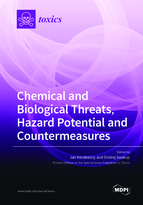Chemical and Biological Threats, Hazard Potential and Countermeasures
A special issue of Toxics (ISSN 2305-6304). This special issue belongs to the section "Human Toxicology and Epidemiology".
Deadline for manuscript submissions: closed (31 July 2022) | Viewed by 20965
Special Issue Editors
Interests: Alzheimer’s disease; acetylcholinesterase; butyrylcholinesterase; cholinesterase; drug development; organic synthesis; medicinal chemistry; organophosphate poisoning; nerve agents; oxime reactivators; toxicology; military pharmacy; in silico methods
Special Issues, Collections and Topics in MDPI journals
Interests: organophosphate poisoning; nerve agents; oxime reactivators; toxicology; military pharmacy; drug delivery Alzheimer’s disease; acetylcholinesterase; butyrylcholinesterase; cholinesterase; drug development;; in vitro testing; in vivo; toxicokinetics
Special Issues, Collections and Topics in MDPI journals
Special Issue Information
Dear Colleagues,
We have issued the Special Issue of Toxics entitled, “Chemical and biological threats, hazard potential and countermeasures”. In this special issue we would like to pay attention to various aspects of toxicology specifically focused on the chemical and biological threats, which may accidentally or on purpose endanger human health. Besides the characterization of such threats and their biological consequences we will focus on the available and novel experimental countermeasures capable to protect from and/or threat such exposures.
We would like to encourage our colleagues from this field for the submission of review or original research articles that encompasses this field at different levels including chemical, biological, medical and epidemiological approaches.
Dr. Jan Korabecny
Dr. Ondrej Soukup
Guest Editors
Manuscript Submission Information
Manuscripts should be submitted online at www.mdpi.com by registering and logging in to this website. Once you are registered, click here to go to the submission form. Manuscripts can be submitted until the deadline. All submissions that pass pre-check are peer-reviewed. Accepted papers will be published continuously in the journal (as soon as accepted) and will be listed together on the special issue website. Research articles, review articles as well as short communications are invited. For planned papers, a title and short abstract (about 100 words) can be sent to the Editorial Office for announcement on this website.
Submitted manuscripts should not have been published previously, nor be under consideration for publication elsewhere (except conference proceedings papers). All manuscripts are thoroughly refereed through a single-blind peer-review process. A guide for authors and other relevant information for submission of manuscripts is available on the Instructions for Authors page. Toxics is an international peer-reviewed open access monthly journal published by MDPI.
Please visit the Instructions for Authors page before submitting a manuscript. The Article Processing Charge (APC) for publication in this open access journal is 2600 CHF (Swiss Francs). Submitted papers should be well formatted and use good English. Authors may use MDPI's English editing service prior to publication or during author revisions.
Keywords
- chemical warfare agent
- organophosphorus compound
- biological agent
- nerve agents
- novichoks
- safety and health
- intoxication
- protection
- decontamination
- hazard potential
- antidote
- countermeasure








